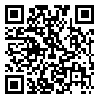BibTeX | RIS | EndNote | Medlars | ProCite | Reference Manager | RefWorks
Send citation to:
URL: http://ijhe.tums.ac.ir/article-1-5156-en.html

 , Adel Jahed2
, Adel Jahed2 
 , Asadolah Rajab3
, Asadolah Rajab3 
 , Amir Kamran Nikuo Sokhantabar4
, Amir Kamran Nikuo Sokhantabar4 
 , Giti Kashi *
, Giti Kashi * 
 5, Rouzbeh Tabatabaee6
5, Rouzbeh Tabatabaee6 

2- 2Department of Internal Medicine Endocrinology, Faculty of Medicine, Islamic Azad University Tehran Medical Branch, BooAli Hospital,Tehran, Iran
3- Department of Pediatric-Diabetology, Iranian Diabetic Society, Tehran, Iran
4- 4Department of Diabetology, International Diabetic Federation Iranian Diabetic Society, Regional Middle East & North Africa Office, Iran, Tehran
5- Department of Environmental Health, Faculty of Health, Islamic Azad University Tehran Medical Branch, Tehran, Iran ,
6- Department of Polymer Engineering, Faculty of Engineering, Islamic Azad University Tehran Science & Research, Tehran, Iran
Background and Objectives: Air pollution and its effects on human health had become a major concern of many healthcare centers decision makers. In this study, air pollution effect on variation of Glycosylated Hemoglobin A1C (HbA1C) level in diabetic patients was evaluated, which is a unique study in Iran and Middle East region.
Materials and Methods: During November-January 2010-11, Tehran, capital of Iran, was exposed with high levels of air pollution. A retrospective cohort study was carried out on 330 patients diagnosed with diabetes mellitus for at least 12 months referring to 3 endocrinal care clinics. A questionnaire in two demographic and diabetic related sections was prepared. The patients' HbA1C level recorded on November-January 2009-10 was compared with November-January 2010-11. Descriptive analysis and paired t-test were carried out using SPSS 18 software.
Results: The patients investigated were divided into two groups. The first group was composed of 108 patients (53.7% female and 46.3% male) with diabetes mellitus type I (Insulin Dependent), age mean of 17.22, and SD of 11.57. The second group was composed of 222 patients (58.6% female and 41.4% male) with diabetes mellitus type II (Noninsulin Dependent), age mean of 53.91, and SD of 12.12. The change of HbAIC level in both groups wa not statistically significant in first group, HbA1C level increased from 7.71 to 7.75 mg / 100 ml (P =0.828) and in second group, it increased from 7.06 to 7.08 mg / 100 ml (P = 0.798).
Conclusion: According to the results obtained, it can be concluded that relation of air pollution and HbA1C mean variation in diabetic patients was insignificant.
Received: 2011/07/18 | Accepted: 2011/10/16 | Published: 2014/01/18
| Rights and Permissions | |
 |
This work is licensed under a Creative Commons Attribution-NonCommercial 4.0 International License. |



